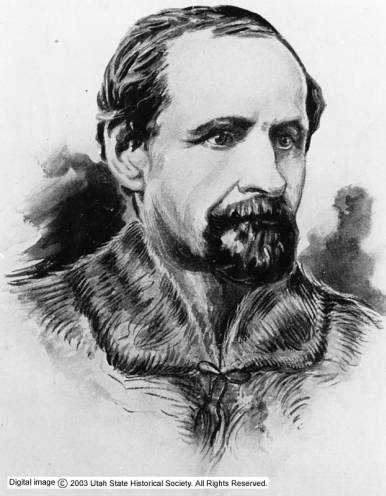|
Etienne Provost was born in Chambly, Quebec, in 1785, but his early life remains a mystery. For thirty-five years he made his home in St. Louis and was one of the more notable figures in the American fur trade. He was among its earliest participants, traveling to the Arkansas River country as early as 1814 with Joseph Philibert, and again in 1815 with Auguste Chouteau and Jules
deMun. He was imprisoned in Santa Fe by the Spanish on both expeditions.
Knowledge gained by these experiences led him back to New Mexico about the year 1822, again, one of the earliest participants in the Santa Fe trade. In 1824 he formed a partnership with one Leclerc to trap the Uinta Basin. At the Jordan River near the Great Salt Lake, his group was attacked by
a band of Snake Indians in October 1824, and lost eight men in the ensuing
massacre. Provost survived and established temporary trading posts on
the shores of both Utah Lake and Great Salt Lake, and he is credited with being the first American to see the Great Salt Lake.
In May 1825 he encountered the Hudson's Bay Company brigade under Peter Skene Ogden in Weber Canyon and witnessed Ogden's famous confrontation with Gardner Johnson, one of William H. Ashley's lieutenants. In June he came upon Ashley's expedition near Fruitland, and agreed to guide Ashley to the first rendezvous on Henry's Fork of the Green River. However, he never became an Ashley employee.
After returning to St. Louis in 1826, he became an employee of the American Fur Company, and until 1830 continued his own trapping ventures while carrying out assignments for the AFC. He married in 1829 and ceased active trapping after 1830. Until 1838 he was engaged in escorting AFC caravans to the annual rendezvous.
From 1839 until his death in 1850 he recruited new employees for the fur company, and escorted them to their river posts each spring. The company also frequently contracted his services as guide to various private expeditions: Nicollet's 1839 mapping expedition; British officers on a buffalo hunt in 1840; Audubon's natural history expedition in 1843; and the Comte D'Otrante party in 1844. In these years, from about 1827 onward, he was also actively engaged in the tavern business, running his own tavern and "grocery."
His last trip upriver was in 1849, and he died on 3 July 1850 in St. Louis. He was a portly individual, having been described in 1837 as "adipose & rotonde, larding the lean earth as he walks along." That he garnered respect is attested in an 1826 letter of Bartholomew Berthold, who described him as "the soul of the hunters in the mountains," and again in 1839 by Nicollet, who said he was one of the five men "certainly worth ten," who accompanied him and who was known as "L'Homme des Montagnes--man of the mountains."
See: Jack B. Tykal, Etienne Provost: Man of the Mountains (1989); Dale L. Morgan, The West of William H. Ashley (1964), and ed., with Eleanor Harris, The Rocky Mountain Journals of William Marshall Anderson (1967); David J. Weber, The Taos Trappers: The Fur Trade in the Far Southwest, 1540-1846 (1971).
|


